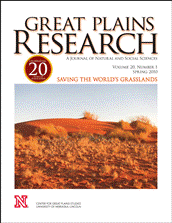Center for Great Plains Studies

Great Plains Research: A Journal of Natural and Social Sciences (through 2013)
Date of this Version
February 1994
Document Type
Article
Abstract
The species composition and soil-site characteristics of three prairies from the Missouri Coteau of southeastern South Dakota were used 1) to determine the major environmental variables responsible for vegetational patterning and 2) to describe the plant communities on these prairies. Vascular plant species composition was significantly correlated (p < 0.01) with a suite of variables that strongly influence available soil moisture, and with soil pH and conductivity. Cluster analysis yielded five groups at the 38% similarity level. From the lowest (in elevation) and most mesic to the highest and most xeric, the five groups (communities) are: wet meadows with prairie cordgrass (Spartina pectinata Link) and sedge (Carex praegracilis W Boott.) as the most important species; meadows with prairie cordgrass and switch grass (Panicum virgatum L.); swales with Kentucky bluegrass (Poa pratensis L.) and big bluestem (Andropogon gerardii Vitman); slopes with Kentucky bluegrass, sideoats grama (Bouteloua curtipendula [Michx.j Torr.), and needleleaf sedge (Carex eleocharis Bailey); and crests with Kentucky bluegrass and needleleaf sedge.


Comments
Published in Great Plains Research 4:1 (February 1994). Copyright © 1994 The Center for Great Plains Studies, University of Nebraska–Lincoln. Used by permission. http://www.unl.edu/plains/publications/GPR/gpr.shtml